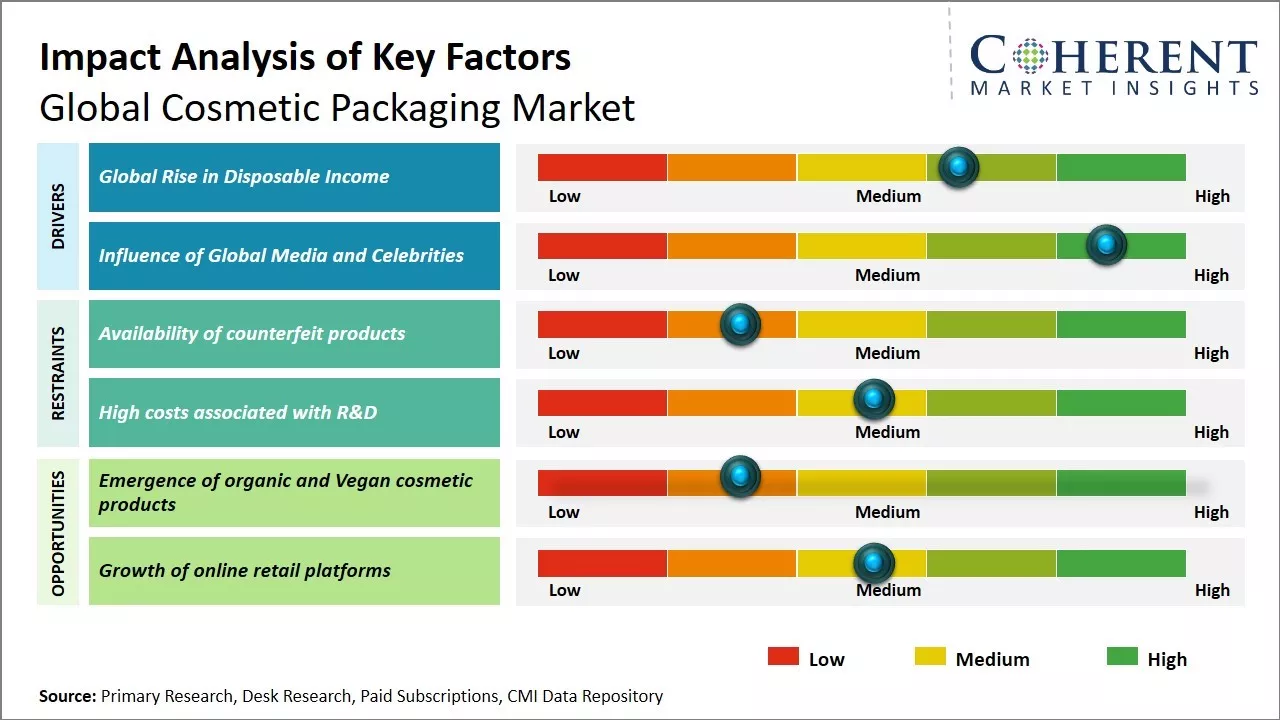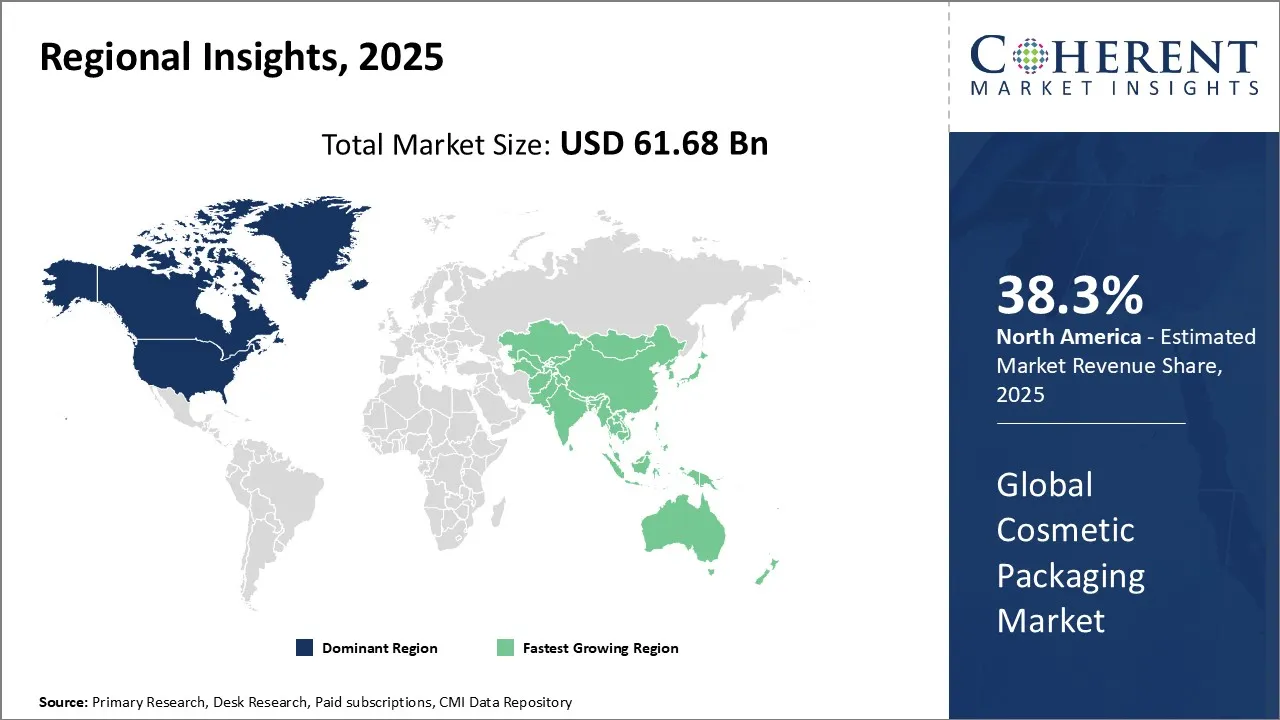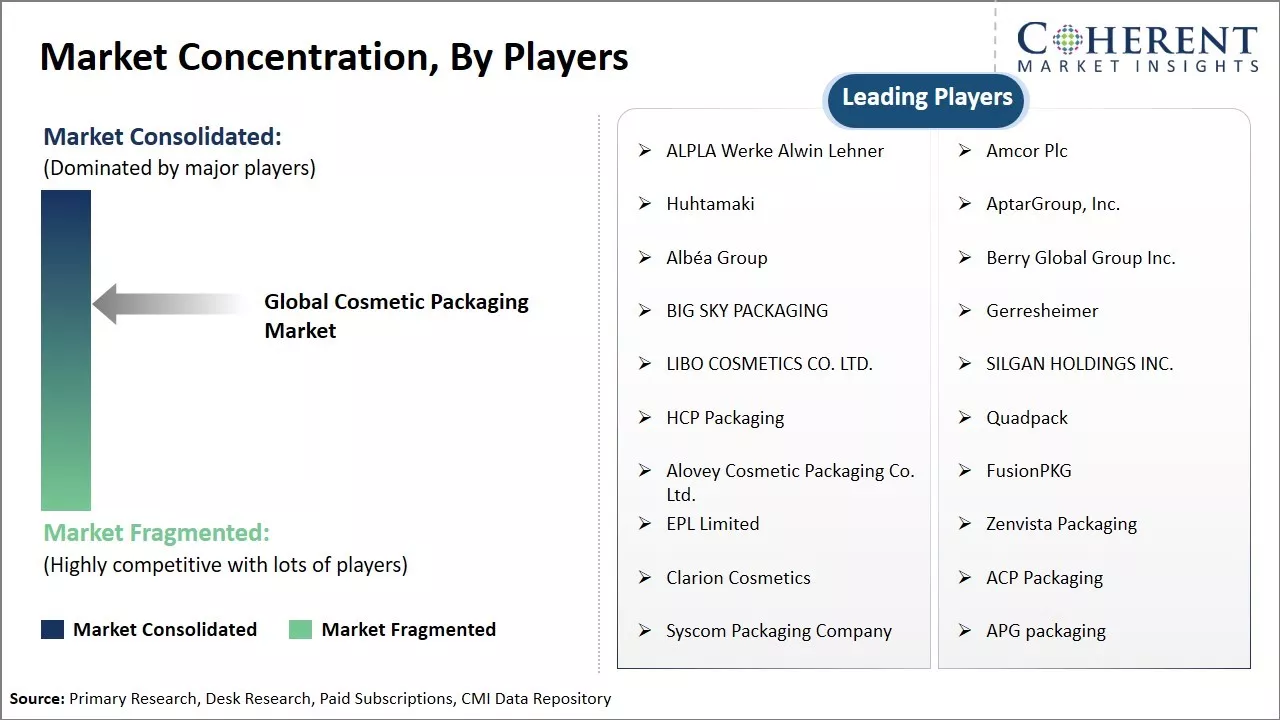The global cosmetic packaging market is estimated to be valued at USD 61.68 Bn in 2025 and is expected to reach USD 85.13 Bn by 2032, exhibiting a compound annual growth rate (CAGR) of 4.7% from 2025 to 2032.

To learn more about this report, Download Free Sample
The cosmetic packaging market is witnessing significant growth trends. There is a rising demand for eco-friendly and sustainable packaging solutions across different cosmetic product types. Manufacturers are focusing on innovative packaging designs with emphasis on product branding and marketing. Rapid urbanization, increasing disposable incomes, and changing lifestyles especially in emerging economies are also driving the demand for enhanced personal care and beauty products, fueling the need for effective cosmetic packaging. However, availability of alternatives and fluctuations in raw material prices can hamper the cosmetic packaging market growth.
|
Current Event |
Description and its Impact |
|
Sustainability Regulations and Environmental Policies |
|
|
Technological Disruption and Digital Transformation |
|
Uncover macros and micros vetted on 75+ parameters: Get instant access to report
Smart packaging is transforming the cosmetic packaging market by merging technology with consumer experience. It includes features like QR codes, NFC tags, and augmented reality that offer personalized skincare guidance, product authentication, and interactive content. These innovations enhance brand engagement, build trust, and combat counterfeiting. As consumers seek more transparency and customization, smart packaging enables brands to deliver tailored solutions while reinforcing product value. With rising demand for connected beauty experiences, smart packaging is becoming a key driver of growth and differentiation in the global cosmetic packaging market.
For instance, in October 2025, Nivea launched interactive cosmetic packaging that offers personalized skincare guidance. By scanning a QR code on the product, users access tailored advice based on their skin needs. This smart packaging enhances consumer engagement, bridges physical and digital experiences, and reflects a growing trend in the cosmetic industry toward connected, user-centric solutions.
In terms of material type, the plastic contributes 58.2% share of the market in 2025. Its widespread use is attributed to its lightweight nature, cost-effectiveness, and adaptability across various product formats. Plastic packaging offers excellent design flexibility, allowing brands to create innovative shapes and finishes that appeal to consumers. Moreover, advancements in sustainable plastics and recycling technologies have helped mitigate environmental concerns, making plastic a more acceptable choice even among eco-conscious brands. While glass and metal are favored for luxury and premium products, plastic remains the go-to material for mass-market cosmetics due to its durability and scalability.
For instance, in February 2025, Mitsubishi Chemical Group and ALBION partnered to recycle used plastic cosmetic containers into new packaging using advanced chemical recycling. The process converts waste into oil, then into recycled polypropylene resin. With plans to launch products by 2025, this initiative promotes a circular economy and reduces environmental impact in the cosmetic packaging industry.
In terms of application, skin care contributes 35.1% share in 2025 to the global cosmetic packaging market. This segment includes a wide array of products such as moisturizers, cleansers, serums, sunscreens, and exfoliants, each requiring specific packaging solutions to preserve efficacy and enhance user experience. The rise in consumer awareness about skin health, coupled with growing demand for anti-aging and organic products, has fueled the expansion of this category. Packaging in skin care often emphasizes functionality, like airless pumps and UV-protective containers, as well as aesthetics, reflecting the brand’s commitment to quality and innovation. As skin care routines become more elaborate, the need for diverse and specialized packaging continues to grow.
For instance, in April 2025, Aptar Beauty expanded its airless packaging portfolio in Latin America with sustainable, high-performance solutions for skincare and dermal products. The new Sierra, Moda, and Luna lines offer recyclable, customizable formats in 15–50 ml sizes, supporting local production and fast market access. These innovations cater to eco-conscious skincare brands seeking premium, protective packaging.
In terms of product type, bottles contribute 35% share to the market in 2025. Their popularity stems from their versatility in storing liquids, creams, and gels, and their compatibility with various dispensing mechanisms such as pumps, droppers, and sprays. Bottles offer a balance of practicality and visual appeal, often serving as the primary packaging for cleansers, toners, shampoos, and lotions. In 2025, brands are increasingly investing in sustainable bottle designs, including refillable formats and biodegradable materials, to align with environmental goals. The ability to customize bottle shapes, colors, and finishes also makes them a powerful tool for brand differentiation on retail shelves and digital platforms.
For instance, in October 2024, Unilever introduced a fully recyclable pump for its Vaseline skincare bottles, eliminating metal springs to support its plastic reduction goals. This innovation enhances the sustainability of bottle packaging in cosmetics, aligning with Unilever’s commitment to circular design and reducing environmental impact across its product portfolio

To learn more about this report, Download Free Sample
North America has established itself as the dominant player in the global cosmetic packaging market with 38.3% of the market share in 2025 driven by top manufacturers like Aptar, RPC Group, and HCP Packaging. The U.S. and Canada’s booming cosmetic industry, fueled by innovation and rising personal care spending, has spurred investment in advanced manufacturing. This enables scale and cost advantages over global rivals. Local firms also export to Europe, Latin America, and Asia Pacific, offering customized solutions like airless bottles and multi-functional components. Strong IP laws protect their designs, reinforcing dominance. Despite competition from China and Europe, North America’s infrastructure and economies of scale remain unmatched.
For instance, in December 2024, Albéa’s North America Collection introduced sustainable cosmetic packaging for lipsticks, mascaras, skincare, and personal care. Made with recyclable materials like r-PET and mono-material PP, the range includes refillable jars, dual-compartment bottles, and customizable compacts. Locally produced at the Matamoros plant, it supports faster delivery, reduced emissions, and eco-conscious beauty innovation.
The Asia Pacific region has emerged as the fastest growing market globally, with countries like China, India, Indonesia, and Vietnam seeing double-digit growth. Key drivers include rising incomes, youth-driven beauty trends, and Western influence. Though still developing in tech and design, the region attracts major global investments. North American and European brands are setting up local units to cut costs and stay close to consumers. New advanced facilities, low-cost skilled labor, and expanding supplier networks make APAC a prime manufacturing hub. If current momentum continues, the region could challenge traditional market leaders in the next decade.
For instance, in September 2025, Cosfinity showcased its diverse cosmetic packaging range at COSMOPACK Asia Hong Kong, featuring innovative designs for lipsticks, mascaras, compacts, and more. Highlights include citrus-inspired lip gloss tubes and metallized foundation bottles. With a focus on aesthetics and functionality, Cosfinity reinforces its position as a creative leader in the global beauty packaging industry.
The U.S. cosmetic packaging market is booming due to rising demand for beauty and personal care products, driven by premiumization, sustainability, and e-commerce growth. Consumers seek high-quality, eco-friendly, and visually appealing packaging. Advanced technologies like smart labels and airless pumps, along with brand-manufacturer collaborations, fuel innovation and meet evolving consumer expectations.
For instance, in May 2025, Origins, part of Estée Lauder Companies, launched on Amazon’s U.S. Premium Beauty store, expanding its digital reach. The brand also updated its packaging portfolio to enhance sustainability, aligning with its Responsible Beauty commitment. These changes reflect Origins’ focus on eco-conscious skincare and improving the environmental impact of its jars, tubes, and bottles.
China’s cosmetic packaging market is booming due to rising demand for beauty and personal care products, premiumization trends, and eco-conscious consumer behavior. The surge in e-commerce drives need for durable, attractive packaging, while innovations like smart labels and airless pumps gain popularity. Global brands invest locally, accelerating design and technology advancements.
For instance, in September 2025, Galderma launched Alastin in China, introducing the brand’s refreshed premium packaging for the first time. The updated design reflects Alastin’s science-driven skincare positioning and enhances its visual identity. This strategic move supports Galderma’s expansion into China’s fast-growing aesthetic market, aligning product presentation with consumer expectations for high-performance and sophisticated beauty solutions.
| Report Coverage | Details | ||
|---|---|---|---|
| Base Year: | 2024 | Market Size in 2025: | USD 61.68 Bn |
| Historical Data for: | 2020 To 2024 | Forecast Period: | 2025 To 2032 |
| Forecast Period 2025 to 2032 CAGR: | 4.7% | 2032 Value Projection: | USD 85.13 Bn |
| Geographies covered: |
|
||
| Segments covered: |
|
||
| Companies covered: |
ALPLA Werke Alwin Lehner, Amcor Plc, Huhtamaki, AptarGroup, Inc., Albéa Group, Berry Global Group Inc., BIG SKY PACKAGING, Gerresheimer, LIBO COSMETICS CO. LTD., SILGAN HOLDINGS INC., HCP Packaging, Quadpack, Alovey Cosmetic Packaging Co. Ltd., FusionPKG, EPL Limited, Zenvista Packaging, Clarion Cosmetics, ACP Packaging, Syscom Packaging Company, and APG packaging |
||
| Growth Drivers: |
|
||
| Restraints & Challenges: |
|
||
Uncover macros and micros vetted on 75+ parameters: Get instant access to report
Rising global disposable incomes have significantly boosted the cosmetic packaging market research in recent years. As people have more spendable income left after paying for essential items, they are increasingly spending on luxury items and personal care products. Consumers are willing to pay premium prices for products that come in attractive, innovative, and sustainable packaging designs. Manufacturers are innovating packaging designs and materials to cater to the evolving preferences of consumers with higher spending power. There is a growing demand for biodegradable packaging made from recycled or plant-based materials. Luxury packaging formats like compacts, sprays, jars and roll-ons are gaining traction. Digitization has also opened new opportunities for interactive and customized packaging. The cosmetic industry is investing heavily in R&D to develop smart and connected packaging incorporated with advanced technologies like augmented reality. For example, some products allow consumers to preview shades through their mobile phones. Personalization is another emerging trend as it allows consumers to feel special. This rising pool of discretionary spending in developing nations will continue driving the worldwide cosmetic market and its packaging needs going forward. Higher disposable incomes will create more opportunities for innovations meeting the evolving requirements of these consumers.

To learn more about this report, Download Free Sample
The availability of counterfeit cosmetic products poses a major challenge to the growth and cosmetic packaging market share globally. Counterfeit cosmetic products are easily available in both online and offline markets which is making it difficult for genuine brands to differentiate themselves. Customers often get confused between original and fake products due to the deceptive packaging of counterfeits. This is negatively impacting the brand image and sales of legitimate cosmetic brands. Counterfeit products use inferior and sometimes toxic ingredients which can cause harm to the health and safety of consumers. People are becoming wary of trying new brands or expensive products due to fears of purchasing spurious items. Loss of consumer confidence poses a serious threat to the demand for genuine cosmetic products and corresponding packaging materials. The prevalence of counterfeiting is also causing significant financial losses to packaging manufacturers as well as cosmetic companies. A study by the European Union Intellectual Property Office estimates that the global trade in counterfeit cosmetics results in annual lost revenues of over USD10 billion for legitimate brands. This wide availability of fakes weakens the competitive positions of original brands in the market. It disincentivizes investments in product innovation, branding and premium packaging experiences. Unless strong measures are taken by regulators and law enforcement to curb the menace of counterfeiting, it will continue restricting the prospects of long-term growth for the global cosmetic packaging industry.
The availability of counterfeit cosmetic products is posing a major challenge for the growth of the global cosmetic packaging market forecast. Counterfeit cosmetic products are easily available in both online and offline markets which is making it difficult for genuine brands to differentiate themselves. Customers often get confused between original and fake products due to the deceptive packaging of counterfeits. This is negatively impacting the brand image and sales of legitimate cosmetic brands. Counterfeit products use inferior and sometimes toxic ingredients which can cause harm to the health and safety of consumers. People are becoming wary of trying new brands or expensive products due to fears of purchasing spurious items. Loss of consumer confidence poses a serious threat to the demand for genuine cosmetic products and corresponding packaging materials.
The cosmetic packaging market value is going through a strategic change in which decisions about packaging have a direct effect on brand equity, pricing power, and perceptions of sustainability. Sustainability has become the most important factor in competition. Consumers now prefer products with packaging that can be shown to be eco-friendly, and brands that use post-consumer recycled (PCR) materials or mono-material designs are gaining trust. Refillable packaging is still a small part of the market, but it is growing quickly. Major beauty companies like L'Oréal have set up refill stations and modular systems to cut down on waste and boost repeat sales.
Material choices are splitting the market into distinct groups. For example, glass and aluminum are popular in high-end lines because they feel good to the touch, while engineered polymers and flexible refills are popular in mass and e-commerce channels because they are cheaper. People are also showing real resistance to too much packaging, which makes it even riskier for businesses to ignore sustainability.
At the same time, digital and smart packaging with QR or NFC-enabled authentication and engagement has become a measurable CRM tool that helps brands fight counterfeiting and get more people to sign up for or refill their subscriptions. Successful players will make sure that new packaging ideas match up with claims about the environment that can be proven, metrics for measuring engagement, and unique looks. At this point, packaging is no longer just a cost center; it is a strategic tool that can affect customer loyalty, compliance with regulations, and long-term profitability across global cosmetic value chains.
Definition: The global cosmetic packaging market consists of companies that manufacture packaging for cosmetic and personal care products like jars, bottles, tubes, caps, pumps, and containers used to package a wide range of beauty products including skin care, hair care, color cosmetics, perfumes, and others. The packaging is designed to protect the product, prevent leakage, promote the brand, and provide convenient usage. This market caters to large cosmetic brands as well as small and private label producers around the world.
Share
Share
About Author
Shivam Bhutani has 6 years of experience in market research and strategy consulting. He is a Market Research Consultant with strong analytical background. He is currently an MBA candidate specializing in Business Analytics from BITS Pilani.
He is adept at navigating diverse roles from sales and marketing to research and strategy consulting. He excels in market estimation, competitive intelligence, pricing strategy, and primary research. He is skilled at analysing large datasets to provide precise insights, helping clients in achieving strategic transformation across various industries. He is skilled in leveraging data visualization techniques to drive innovation and enhance business processes.
Missing comfort of reading report in your local language? Find your preferred language :
Transform your Strategy with Exclusive Trending Reports :
Frequently Asked Questions
Joining thousands of companies around the world committed to making the Excellent Business Solutions.
View All Our Clients